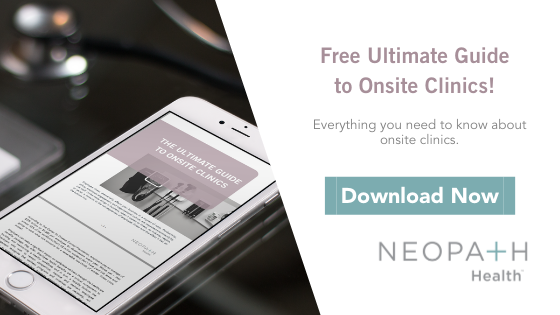An increasing number of employers are looking to onsite clinics as an innovative approach to controlling corporate healthcare costs. The National Association of Worksite Health Centers conducted surveys in 2014 and 2018 to gauge how many employers offered onsite clinics. In 2018 they found that 33% of U.S. employers with 5,000 or more employees provided onsite clinics in 2017 — up from 24% in 2012. While only 16% of organizations with 500-4,999 employees provided an onsite clinic in 2017, 8% said they planned to add one by 2019.
Employers are turning to onsite and near-site clinics as a strategy to reduce healthcare costs because of the numerous benefits they provide. Onsite clinics improve employee access to healthcare, reduce the overall cost of care, and are a unique competitive advantage for employers.
Want to know what’s involved in implementing an onsite clinic? Download the checklist here.
Improved access to care
People often put off seeking healthcare when it’s inconvenient for them to visit the doctor. Onsite clinics improve access to care by placing clinics directly at the workplace. Onsite clinics break down two critical barriers to receiving care: having to travel to get to a clinic and having to take several hours off work to see the doctor.
With improved access to care, employees are more likely to go to the doctor for preventive care, management of chronic disease, and acute illnesses. Regularly seeking care helps prevent future diseases or health crises that result from a lack of managing chronic disease. Health prevention and maintenance reduces the risk of costly adverse events, like hospitalizations, that drive corporate healthcare costs up and keep employees away from work for extended periods.

Reduced cost of care
Onsite clinics are cost-effective because they favor primary care, which reduces expensive specialty referrals and claims. Reducing these claims is a significant cost saving, especially considering nearly 52% of healthcare providers say they make unnecessary specialty referrals. Onsite clinics also allow employees to receive care without submitting claims to the health insurance provider, which helps stabilize health insurance rates.
Onsite clinics can also offer standard laboratory services, which reduces the cost associated with sending labs to expensive laboratory providers. Some onsite clinics can even dispense generic medications without pricey retail markups. Having an onsite pharmacy cuts out dispensing fees and reduces the actual price of the drugs because they’re being purchased directly from a distributor.
The cost-effectiveness of onsite clinics means employers can often cover the full cost of care for their employees, breaking down the employees’ financial barriers to accessing care. Employees are more likely to seek care when they need it when they aren’t held back by financial limitations.
Plus, when employees can get generic medications onsite, it not only reduces the cost of drugs for the employer and the employee, but it also enables employees to better adhere to their medication instructions. Medication adherence helps employees manage their chronic conditions, further reducing the risk of costly adverse events.
Calculating the ROI of an onsite clinic
Implementing an onsite clinic requires an upfront cost, so the role it plays in reducing employer healthcare costs is not always clear. Here’s a step-by-step approach to calculating the ROI for your organization:
- Take the overall projected value of the clinic services, using standard CPT rates and the average cost of services
- Add the medication savings discovered by cutting out the costs of dispensing medications and ordering directly from a distributor
- Add the potential saving of having the ability to treat your employees in-house and keeping the referral rate to specialists below the 33% industry average
- By adding these numbers, you now have the overall value of your onsite clinic. Now subtract the actual clinic costs for all operations and supplies. This resulting number is the onsite clinic’s ROI
Consider the example below. All values provided are for demonstration purposes only.
Value of Onsite Clinic Services (Ex: $500,000 annually)
+
Generic Medication Savings (Ex: $100,000 annually)
+
Deferred Specialist Savings (Ex: The average referral rate in primary care is about 33%, but an onsite clinic’s referral rate can be as low as 5%. Estimate 1,000 annual visits with the average specialty visit costing $400. This saves the client $60,000 on referrals annually.)
=
Total Clinical Value = $660,000
Clinic Costs = $380,000
Total Clinical Value $660,000 – Clinic Costs $380,000 = $280,000 ROI
Learn more about calculating the ROI of an onsite clinic here.
Business benefits beyond direct health costs
Onsite clinics also amplify efforts to create a culture of health. Increased utilization of primary care and access to labs and medications can improve the overall health and wellness of employees. When employees are healthy, they miss less work and are less likely to show up to work sick, performing at a lower capacity. Healthier employees can engage in their job more effectively, which increases their productivity.
Onsite clinics can also improve recruitment and retention efforts. Having easy access to low- or no-cost health care is a differentiating benefit. Employees are increasingly attracted to organizations that prioritize employee health and well-being. Providing access to high-quality primary care demonstrates that you care and are committed to your employees. When employees are satisfied with the benefits you offer, they’re also more likely to recommend you as a place to work.
Improved productivity, recruitment, and retention all have financial business benefits not often considered when evaluating how to control corporate healthcare costs.






